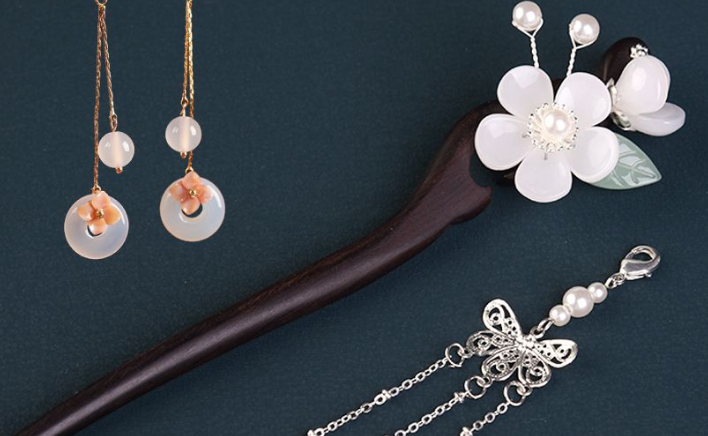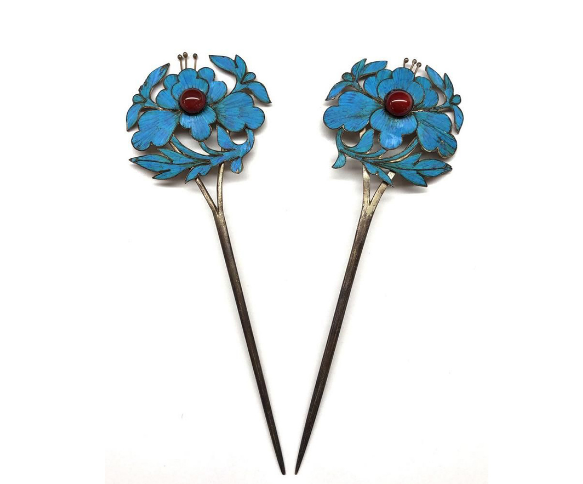Traditional Hanfu accessories include hair ornaments, jewelry, belts, sashes, fans, and parasols.
Hanfu Overview
Hanfu, the traditional attire of the Han Chinese people, has a rich history that dates back over 3000 years. Originating in the Yellow River Valley, Hanfu evolved through various dynasties, each adding unique elements and styles. This attire is not just clothing; it represents a deep cultural heritage and aesthetic. Today, Hanfu enjoys a resurgence among young people in China, symbolizing a reconnection with their cultural roots.
Historical Significance of Hanfu
Hanfu was more than mere clothing for the ancient Chinese; it embodied the philosophies, ethics, and societal norms of the time. Confucian ideals, for instance, heavily influenced Hanfu’s design, emphasizing modesty and propriety. During the Han Dynasty, the Hanfu became a symbol of cultural identity, distinguishing the Han people from other ethnic groups. It also reflected social status and occupation, with variations in color, pattern, and style indicating one’s position in society.

Varieties of Hanfu Styles
Over centuries, Hanfu evolved into various styles, each with distinct characteristics. The ‘Ruqun’, a combination of a blouse and a wrap-around skirt, was popular among women. The ‘Shenyi’, a one-piece garment, was the epitome of formality and elegance. Men often wore the ‘Zhiju’, a loose robe with broad sleeves. These styles were not only aesthetically pleasing but also practical, suited to the lifestyle and climate of the region.
Each Hanfu piece is a testament to the exquisite craftsmanship of ancient China. Luxurious fabrics like silk were common among the nobility, while commoners often wore hemp or cotton. Intricate embroideries and patterns, often inspired by nature and mythology, added to the elegance of Hanfu. This attire is more than just a fashion statement; it is a living history, an art form, and a celebration of Chinese cultural heritage.
For a deeper understanding, readers can explore related topics on Hanfu, Chinese culture, and traditional textile arts.
Primary Accessories in Hanfu Attire
Accessories play a crucial role in Hanfu attire, adding layers of meaning and beauty to the traditional Chinese dress. These accessories not only enhance the visual appeal but also carry cultural and historical significance. Each piece, whether it’s a hair ornament or a piece of jewelry, has its own story and place in the rich tapestry of Chinese culture.
Hair Accessories
Hair accessories in Hanfu culture are not just decorative; they are symbols of age and marital status. Young, unmarried women often wear intricate hairpins and combs, usually adorned with pearls and jade. These ornaments are more than just embellishments; they signify youth and elegance. Traditional hairstyles, like the ‘Shuang Fei Yan’ or ‘butterfly’ style, often require the use of these accessories to maintain their shape and add an extra touch of grace.
For detailed insights into the variety and symbolism of these accessories, one can explore resources on traditional Chinese hair ornaments.
Jewelry
Jewelry in Hanfu attire, made from precious metals and stones, represents more than just wealth or status. Necklaces often feature jade, a stone deeply embedded in Chinese culture, symbolizing purity and moral integrity. Bracelets and rings, crafted with meticulous attention to detail, often bear inscriptions or designs that carry specific meanings, such as blessings for health or prosperity.
These accessories are not only aesthetically pleasing but also serve as a link to the past, keeping alive the traditions and values of ancient China. To delve deeper, readers can explore Chinese jewelry and its significance in the cultural landscape.
In these accessories, one finds a blend of artistry, tradition, and cultural identity. They are indispensable elements of Hanfu attire, each piece contributing to the storytelling of a rich cultural heritage. Through them, wearers connect with their past, celebrate their culture, and bring ancient traditions into the present.
Additional Hanfu Adornments
Hanfu, the traditional Chinese attire, is renowned for its elegance and historical significance. Apart from the primary garments, additional adornments like belts, sashes, fans, and parasols play a vital role in enhancing the beauty and functionality of Hanfu. These accessories not only complement the attire but also carry deep cultural meanings and practical uses.
Belts and Sashes
Belts and sashes in Hanfu attire are not mere functional items for fastening the garments; they are significant fashion statements. A belt, often made of silk or brocade, is a key element in Hanfu, emphasizing the wearer’s silhouette. The style and material of the belt can indicate the wearer’s social status. For instance, a belt adorned with jade pieces was typically reserved for the nobility. Sashes, on the other hand, add fluidity and grace to the attire. They are often long, allowing for intricate knotting techniques, each with its own symbolism and occasion. For instance, a ‘Ru Yi’ knot symbolizes good wishes and is often seen at celebrations.
For further exploration on the historical context and styles, one might find Chinese belts and sashes insightful.
Fans and Parasols
Fans and parasols, beyond their practical uses, are iconic in Hanfu culture for their artistic and symbolic values. Fans, made of bamboo, wood, or fine paper, often feature calligraphy and paintings. They are not just tools for air circulation; they are also used in traditional dances and as a means of non-verbal communication in ancient times. The folding fan, known as ‘Zhe Shan’, is particularly popular for its portability and elegance.
Parasols, primarily used for protection against the sun, are often crafted with silk and bamboo. They are much more than sunshades; they are a part of the aesthetic ensemble, often matching the colors and patterns of the Hanfu. Embroidered parasols are particularly prized for their beauty and craftsmanship.
In these accessories, one finds a delightful blend of functionality, art, and symbolism, integral to the Hanfu experience. They reflect the ingenious ways in which ancient Chinese culture infused everyday objects with beauty and meaning, making them enduring symbols of a rich cultural heritage.

Footwear and Handwear in Hanfu Fashion
In Hanfu, the traditional Chinese attire, footwear and handwear embody the elegance and cultural depth of the attire. These accessories, far from being mere add-ons, play crucial roles in complementing and enhancing the overall aesthetic of Hanfu.
Traditional Shoes and Boots
Traditional Chinese shoes and boots, essential to the Hanfu ensemble, vary widely in style and purpose. Craftsmen make ‘Bu Xie’, soft fabric shoes, usually from cotton or silk, and often adorn them with intricate embroidery. These designs, featuring flowers, birds, or dragons, symbolize various cultural beliefs and stories. For example, lotus flower designs represent purity and elegance.
For formal wear or higher social status, boots made of finer materials like brocaded silk are more common. These boots, reaching up to the calf and fastened with intricate lacing, often feature soles made from layered cloth or leather for durability and comfort.
Men’s shoes tend to prioritize practicality, with thicker soles and minimal decoration, reflecting societal roles. In contrast, women’s shoes, especially for the upper classes, often showcase ornate designs and sometimes feature raised platforms, indicating status while keeping the wearer’s feet clean.
Gloves and Handkerchiefs
Gloves and handkerchiefs in Hanfu culture hold significant cultural and aesthetic value. Makers typically craft gloves from fine silk or soft cotton, designing them intricately with embroidery to symbolize refinement, especially in colder regions.
Handkerchiefs occupy a special place in Hanfu culture for their practical and symbolic roles. Fine silk handkerchiefs, often featuring exquisite embroidery, not only serve personal grooming needs but also signify the wearer’s taste and status. In historical contexts, people used handkerchiefs in rituals and ceremonies, with specific embroidery patterns denoting the occasion.
Handkerchiefs often facilitated social interactions, serving as tokens of affection or respect when exchanged among friends and loved ones. The embroidery on these handkerchiefs often carried specific messages or sentiments.
These accessories, from shoes to handkerchiefs, demonstrate the elegance and artistic expression inherent in Hanfu fashion. They not only fulfill functional needs but also represent the historical continuity and rich cultural heritage of China, integral to the full appreciation of traditional Chinese attire.







